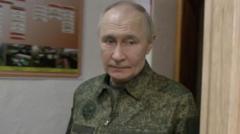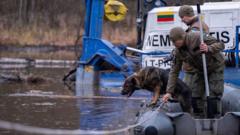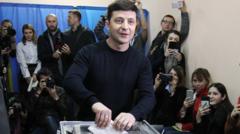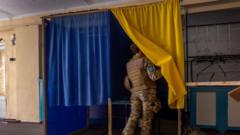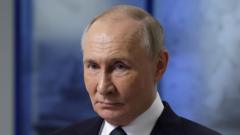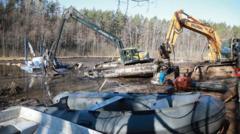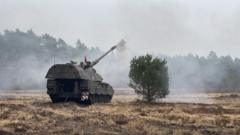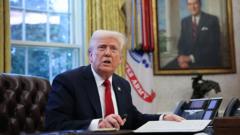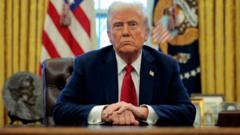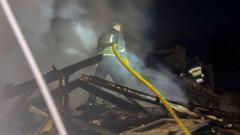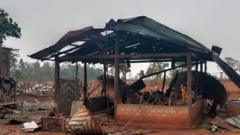In a notable escalation, President Putin has announced a military draft of 160,000 men aged 18-30, representing the largest such call-up since 2011. While the Kremlin insists these conscripts will not be deployed to Ukraine, reports suggest otherwise as regional violence persists. The move reflects Russia’s attempts to bolster military strength amidst losses in the ongoing war.
Russia Initiates Largest Military Draft in Over a Decade Amid Ongoing Conflict
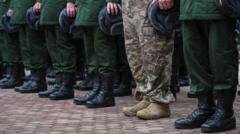
Russia Initiates Largest Military Draft in Over a Decade Amid Ongoing Conflict
President Putin has ordered a significant military call-up of 160,000 conscripts, igniting concern over rising tensions and military engagements in Ukraine.
In a significant move that emphasizes Russia's military ambitions, President Vladimir Putin has initiated a call-up of 160,000 young men aged 18-30 for military service, marking the most substantial conscription effort since 2011. This call-up comes as part of Russia's broader strategy to expand its military capacity, which Putin previously stated should reach nearly 2.39 million in total personnel, including 1.5 million active servicemen over the next three years.
The current draft, scheduled for the spring months from April to July, follows earlier announcements regarding military expansion. Vice Admiral Vladimir Tsimlyansky has explicitly stated that the new conscripts will not be sent to fight in Ukraine, which Russia refers to as its "special military operation." However, discrepancies arise from earlier reports indicating that some conscripts have indeed been sent to the frontlines in Ukraine, particularly in the initial phases of the war.
This large-scale draft is a part of Russia's long-standing practice of annual recruitment but stands out as it surpasses last year’s recruitment figures by 10,000. The recent changes to draft policies include an extended age limit for eligible conscripts, which now encompasses young men up to 30 years old, a departure from the previous cutoff of 27. Notification methods have also evolved, with draft notices now being issued via the state services website, Gosuslugi, in addition to traditional postal methods.
Despite ongoing diplomatic efforts from the United States to broker a ceasefire, violence continues unabated, as evidenced by a recent Ukrainian report detailing a Russian attack that left 45,000 without power in the southern city of Kherson. The announcement of this call-up coincides with Russia’s military claims of capturing additional territory in Ukraine, including a village in the Donetsk region.
In response to extensive military losses, now estimated at over 100,000 soldiers as reported by BBC and other agencies, the Russian government is relying not only on conscription but also on contract soldiers and recruits from countries like North Korea. The defense ministry has attributed its military size growth to "increasing threats" due to the conflict and NATO's expansion, particularly with the inclusion of Finland and Sweden as members.
Finland's Prime Minister, Petteri Orpo, has stated that in light of military assessments, Finland will resume the use of anti-personnel mines, altering its previous commitments under the Ottawa convention. This reflects broader regional military adjustments influenced by the perceived threat from Russia, coupled with an increase in Finland's defense spending to 3% of its GDP.
As the war in Ukraine continues to evolve, implications of this significant military draft stretch beyond Russian borders, drawing in NATO's strategic responses and regional security policies.
The current draft, scheduled for the spring months from April to July, follows earlier announcements regarding military expansion. Vice Admiral Vladimir Tsimlyansky has explicitly stated that the new conscripts will not be sent to fight in Ukraine, which Russia refers to as its "special military operation." However, discrepancies arise from earlier reports indicating that some conscripts have indeed been sent to the frontlines in Ukraine, particularly in the initial phases of the war.
This large-scale draft is a part of Russia's long-standing practice of annual recruitment but stands out as it surpasses last year’s recruitment figures by 10,000. The recent changes to draft policies include an extended age limit for eligible conscripts, which now encompasses young men up to 30 years old, a departure from the previous cutoff of 27. Notification methods have also evolved, with draft notices now being issued via the state services website, Gosuslugi, in addition to traditional postal methods.
Despite ongoing diplomatic efforts from the United States to broker a ceasefire, violence continues unabated, as evidenced by a recent Ukrainian report detailing a Russian attack that left 45,000 without power in the southern city of Kherson. The announcement of this call-up coincides with Russia’s military claims of capturing additional territory in Ukraine, including a village in the Donetsk region.
In response to extensive military losses, now estimated at over 100,000 soldiers as reported by BBC and other agencies, the Russian government is relying not only on conscription but also on contract soldiers and recruits from countries like North Korea. The defense ministry has attributed its military size growth to "increasing threats" due to the conflict and NATO's expansion, particularly with the inclusion of Finland and Sweden as members.
Finland's Prime Minister, Petteri Orpo, has stated that in light of military assessments, Finland will resume the use of anti-personnel mines, altering its previous commitments under the Ottawa convention. This reflects broader regional military adjustments influenced by the perceived threat from Russia, coupled with an increase in Finland's defense spending to 3% of its GDP.
As the war in Ukraine continues to evolve, implications of this significant military draft stretch beyond Russian borders, drawing in NATO's strategic responses and regional security policies.

